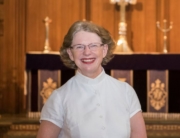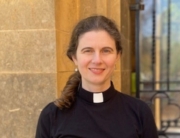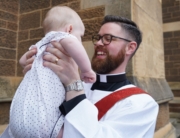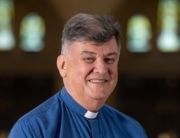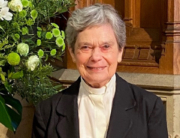Preacher: The Rev’d Dr Lynn Arnold AO
Mi laikim tumas Bikpela
May the words of my mouth and the meditations of our hearts be acceptable in your sight, O Lord, our Rock and our Redeemer.
Mi laikim tumas Bikpela i helpim mi, na mi wet long em. Na mi bilip tru long tok bilong en.
I wait for the Lord, my soul waits, and in his word I hope. [Ps 130:5]
Words from verse five of our psalm tonight that was so beautifully and hauntingly sung by our choir. Tonight we are remembering twelve people who died in the land of Tok Pidgin, the Martyrs of New Guinea – Rev Vivian Redlich, Sr May Hayman, Miss Mavis Parkinson, Rev Henry Holland, John Duffill, Miss Lilla Lashmar, Sr Margery Brenchley, Lucian Tapiedi, Rev Henry Mathews, Leslie Gariardi, Rev John Barge and Rev Bernard Moore. These twelve Anglicans were amongst four hundred missionaries who lost their lives in PNG in World War II, mainly in 1942. The Japanese, as part of what at the time seemed their unstoppable sweep southwards towards Australia, had reached Buna on the northern coast of PNG in early 1942, and had started a southward push towards the Kokoda Trail. Many expatriates fled while many locals, with nowhere to go, had to decide how they would respond to this invasion by yet another colonising nation, having already had British and German colonial rulers followed by Australian.
In his welcome in tonight’s pew sheets, Frank has given a website link to an ABM publication on the Martyrs of New Guinea and the context of their time. I commend this publication to you. www.abmission.org/data/Publications/4526_Martyrs_Booklet_pp32.pdf
In January 1942, in response to the invasion, the Anglican Bishop of New Guinea, Philip Strong, instructed Anglican missionaries to remain at their posts. Here is part of what he said in a radio broadcast on January 31st at 3.30pm:
My brothers and sisters, fellow workers in Christ, whatever others may do, we cannot leave. We shall not leave. We shall stay by our trust. We shall stand by our vocation. We do not know what it may mean to us. Many already think us fools and mad. What does that matter? If we are fools, ‘we are fools for Christ’s sake.’
These were no easy words said from a safe place, for Bishop Strong had only just returned from a hazardous trip visiting all the mission posts in PNG. During that trip, the boat he was travelling in was fired upon by the Japanese, and in some of the locations there were times when they had to flee to safety.
Those I named a moment ago and who are recorded in the pew sheets this evening, were amongst those who responded to the Bishop’s call and all, save Rev James Benson, would die as a result. Five priests, aged between 25 and 50, native evangelists, a store manager and his young son, two nurses and a teacher. The two youngest of the group, the teacher and a nurse, had already left the mission at Sangara in the wake of news of the Japanese landing; but on hearing that the Bishop and other staff remained at their posts, they returned.
Alan Gill, a journalist who has studied the history of this time and place and at one time worked with ABM, has stated that:
Because of their ages, it was deemed that the approval of their parents would have to be given (for these two), and over the air[waves], a plea by one of them could be heard all down the line as she called out: ‘Please let me stay.’
These would be the last words the parents of Mavis Robinson would ever hear from their daughter. Eight months later she and the others had fallen into the hands of the invaders. In her case, along with May Hayman, she was taken to a rubber plantation where an open grave lay before them. One of the soldiers tried to embrace Mavis. She fought back so the soldier plunged a bayonet into her side. She screamed and covered her eyes with cloth; another soldier then bayoneted her in the throat. She was summarily pushed into the freshly dug grave to be followed by May Hayman.
Each of the twelve has their own story, each of which deserves to be individually memorialised, but tonight I want to focus on the story of just one of them – that of Lucian Tapiedi.
Lucian was born about 1921 and so was only twenty or twenty one when he died. It has been variously reported that either his uncle or his father was a sorcerer in Taupota village in the Milne Bay district – perhaps they both were. Whatever the case, Lucian would be educated at a mission school where he was influenced by his teacher Nita Inman and a Papuan priest, Rev Edwin Nuagoro. Upon finishing school he entered St Aidan’s Teacher Training College at Dogura where he was remembered ‘as a diligent and cheerful presence, fond of physical recreation’; he also loved music. He completed studies in 1941 and joined the staff at Sangara, a little to the east of Kokoda; here he was a teacher and an evangelist … and was just twenty years of age.
That July and August were chaotic days seventy five years ago, in Sangara. The mission team retreated into the jungle – deeper and deeper as the Japanese advanced. At first they were sheltered within largely Christian communities but later, as they went farther into the jungle, they found themselves amongst animist communities of uncertain loyalties. Lucian Tapiedi would make daily sorties in search of food for the group. It has been reported that, when it was suggested he could safely stay at the mission since only the expats needed to seek safety, he had said “I will stay with the Fathers and the Sisters”. Without thought to his own well-being he cast his lot with others who needed him.
From their place of hiding, the group decided to make for the coast in order to get to safer territory. Lucian saw his task now to accompany them to safety; but here he was brutally stopped from being able to protect his brothers and sisters in Christ, or even himself. The killing of Lucian Tapiedi has been imperfectly recorded; one story has it that he had been asked to return to the mission to retrieve some records and money and that it was then that he was killed. Two facts are known, however – one that he was axed to death near a stream by Kurumbo village; and the other that his killer was not a Japanese soldier but a local Papuan by the name of Hivijapa. In those troubled months, many local Papuans had found themselves having to read the portents of what the future might hold for them. Hivijapa was one who sensed an inevitable Japanese victory. With Lucian dead, the remainder of the group were gathered up by the locals and handed over to the Japanese. After brutal interrogation, six were beheaded, including a young boy. Some were buried, some cast into the sea.
Lucian Tapiedi was buried at Sangara station at a location separate from the others. Alan Gill tells the story of the delayed recognition of what Lucian Tapiedi had done for the other missionaries in the remaining days of his life. He says:
In about 1950, an Anglican bishop turned up at the mission station in order to bless the graves where these people had been buried. A little boy came up to him and tugged at his sleeve. He kept on repeating, over and over again, the word ‘Lucian’. Eventually the bishop understood that he’d obviously missed somebody out. The little boy then led him to where there was another grave – it was obviously that of Lucian Tapiedi.
As a result, Lucian’s grave was moved next to those of his fellow martyrs interred there. Subsequently, in 1998, it would be his name and likeness that would be included as a C20 Christian martyr in one of ten niches over the west door of Westminster Abbey in London.
In 1946, the Sacred Synod of the Diocese of New Guinea determined to remember the New Guinea martyrs by an annual feast – the Feast of the New Guinea Martyrs. Years later, Philip Strong, by now an Archbishop, would write:
I knew intimately all those who suffered and died in Papua; they were my dear fellow workers in Christ and I know the strong faith and deep conviction that animated them in their resolution. Without doubt they were all good soldiers of Jesus Christ. In their deaths they have glorified God and helped to save His Church which is the Body of Christ in New Guinea.
Following a subsequent investigation into the deaths of the mission staff, 34 Papua New Guineans were executed – ten on the charge of treason. The crime of those ten had not so much been their involvement in the murder of the missionaries as having shown loyalty to the Japanese invaders. However, perhaps because he had not murdered a white foreigner, Hivijapa escaped execution – indeed he wasn’t even charged. So Hivijapa returned to his community and carried on with his life.
Prof Jim Griffin, a former history professor at the University of PNG recalled a conversation that Bishop Hand, successor to Bishop Strong, had when visiting a church named St Lucian’s in memory of Lucian Tapiedi. The Bishop was with the local architect who had given his services for free in designing the church, and who was also an active church council member. Griffin went on to record a conversation between the bishop and the architect:
‘Do you happen to know who killed Lucian?’ asked the bishop. With what I can only call the bright candour of the born-again, the architect immediately replied: ‘Yes, I killed him.”
Sometime after brutally axing Lucian Tapiedi to death, Hivijapa came to faith and was baptised taking the baptismal name of Lucian. Bishop Hand would say of this encounter:
The church of St Lucian was (Hivijapa’s) own personal way of penitence and repentance.
I don’t know what this story brings to mind for you; but for me, I thought of the apostle Paul and his complicity in the stoning of the first recorded Christian martyr – Stephen.
The church that Lucian Hivijapa built at Higatury in memory of the young man he murdered would flourish and become a diocesan centre until its destruction following a volcanic eruption in 1951. The church of St Lucian and the diocesan centre were then rebuilt in a different location – in Popondetta, where, coincidentally, in a local Christian bookshop, I bought the copy of the Buk Baibel from which I have read tonight. Lachlan Clyne and myself were in Popondetta awaiting a flight back to Port Moresby having completed a nine-day trek of the Kokoda Trail in April 2013.
Why do we have annual feast days such as this one to the New Guinea Martyrs? Clearly we take this annual chance to honour them and their faithfulness. But surely we should be called to more than professions of ‘well done, thou good and faithful servants’. Stories such as these are meant to do more than simply move us; they should also motivate us.
On October 11, at St Peter’s in Melbourne, Canon Farnham Maynard preached a sermon at Evensong on the New Guinea martyrs. That sermon may have been the first official recognition of the group as martyrs though it is unfortunate that Lucian Tapiedi was not named amongst those being remembered. In his sermon, Canon Maynard said:
My brethren, it is in such crises that the metal is proved. But it is not in such crises that metal is created. The characters of those missionaries was formed in the days of peace, and formed in prayer and through the grace of the sacraments.
Perhaps this then is the motivating message that we can draw from our reflections upon the New Guinea martyrs. We can ask ourselves: how do we spend our days of peace? Are they days ‘formed in prayer … through the grace of the sacraments’? Are our days of peace a time when our spiritual metal is being created so that if awful circumstances befall us, our spiritual metal can be proved?
One of the martyrs, Rev Vivien Redlich, had been encouraged to go into hiding on a Saturday as it had become known that a local who resented the missionaries had reported him to the Japanese. He refused, saying that it would be the Lord’s Day on the morrow and he must celebrate Mass for the local community. The Eucharist having been celebrated, only then did he go to join the others. Though his body has never been found, we can be certain that, as expressed in the reading from Zephaniah tonight, God brought Vivian Redlich home, he gathered him. Vivien Redlich had been creating his spiritual metal right up until the last moment when, fatefully, it would be proved.
Back in September 2014, when I preached on “Praying Kokoda”, I quoted Rowan Callick:
In what way were Fr Vivien (Redlich) or Lucian Tapiedi different from any of us? In what way are we facing challenges of conscience? In what way are we preparing ourselves through spiritual discipline and education in the truth, the life-changing confrontations that may come our way? There is only one way, one truth, one life through which we can do this.
That way, that truth and that life was and is Jesus, the son of God; proclaimed in the New Testament, foretold in the Old. In our Old Testament reading tonight we had those wonderful words which would have been known to Lucian and the other martyrs from Buk bilong Profet Sefanaia:
Long dispela De bai mi kisim yupela long olgeta hap yupela i stap long en, na bai mi bringim yupela i kam bak long as ples;
At that time I will bring you home, at that time when I gather you; [Zephaniah 3:20a]
Beautiful words of comfort in the wake of dark times. The New Guinea martyrs faced such dark times and God brought them home, he gathered them to himself. And as that verse from Zephaniah continues:
I will make you renowned and praised among all the peoples of the earth.
This Feast day recognises that renown and praise. And so we not only commemorate this Feast day but celebrate it; and take courage from the faithful example of those New Guinea martyrs for our own selves and the lives we create and seek to prove.
In a few moments, the choir the Anthem ’O for a closer walk with God, the third verse beautifully speaks of lives proved:
So shall my walk be close with God,
Calm and serene my frame;
So purer light shall mark the road
That leads me to the Lamb

